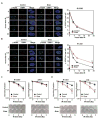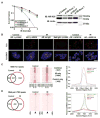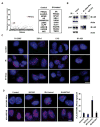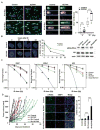Androgen Receptor Variants Mediate DNA Repair after Prostate Cancer Irradiation
- PMID: 28754673
- PMCID: PMC5600864
- DOI: 10.1158/0008-5472.CAN-17-0164
Androgen Receptor Variants Mediate DNA Repair after Prostate Cancer Irradiation
Abstract
In prostate cancer, androgen deprivation therapy (ADT) enhances the cytotoxic effects of radiotherapy. This effect is associated with weakening of the DNA damage response (DDR) normally supported by the androgen receptor. As a significant number of patients will fail combined ADT and radiotherapy, we hypothesized that DDR may be driven by androgen receptor splice variants (ARV) induced by ADT. Investigating this hypothesis, we found that ARVs increase the clonogenic survival of prostate cancer cells after irradiation in an ADT-independent manner. Notably, prostate cancer cell irradiation triggers binding of ARV to the catalytic subunit of the critical DNA repair kinase DNA-PK. Pharmacologic inhibition of DNA-PKc blocked this interaction, increased DNA damage, and elevated prostate cancer cell death after irradiation. Our findings provide a mechanistic rationale for therapeutic targeting of DNA-PK in the context of combined ADT and radiotherapy as a strategy to radiosensitize clinically localized prostate cancer. Cancer Res; 77(18); 4745-54. ©2017 AACR.
©2017 American Association for Cancer Research.
Conflict of interest statement
Figures




Comment in
-
Prostate cancer: A variety of therapy: ARVs mediate DDR.Nat Rev Urol. 2017 Oct;14(10):581. doi: 10.1038/nrurol.2017.135. Epub 2017 Aug 16. Nat Rev Urol. 2017. PMID: 28813038 No abstract available.
Similar articles
-
MDM2 Inhibition Sensitizes Prostate Cancer Cells to Androgen Ablation and Radiotherapy in a p53-Dependent Manner.Neoplasia. 2016 Apr;18(4):213-22. doi: 10.1016/j.neo.2016.01.006. Neoplasia. 2016. PMID: 27108384 Free PMC article.
-
A novel selective androgen receptor modulator (SARM) MK-4541 exerts anti-androgenic activity in the prostate cancer xenograft R-3327G and anabolic activity on skeletal muscle mass & function in castrated mice.J Steroid Biochem Mol Biol. 2016 Oct;163:88-97. doi: 10.1016/j.jsbmb.2016.04.007. Epub 2016 Apr 19. J Steroid Biochem Mol Biol. 2016. PMID: 27106747
-
Androgen receptor signaling regulates DNA repair in prostate cancers.Cancer Discov. 2013 Nov;3(11):1245-53. doi: 10.1158/2159-8290.CD-13-0172. Epub 2013 Sep 11. Cancer Discov. 2013. PMID: 24027196 Free PMC article.
-
DNA-PK, Nuclear mTOR, and the Androgen Pathway in Prostate Cancer.Trends Cancer. 2020 Apr;6(4):337-347. doi: 10.1016/j.trecan.2020.01.015. Epub 2020 Feb 18. Trends Cancer. 2020. PMID: 32209447 Review.
-
Androgen Receptor Gene Pathway Upregulation and Radiation Resistance in Oligometastatic Prostate Cancer.Int J Mol Sci. 2022 Apr 26;23(9):4786. doi: 10.3390/ijms23094786. Int J Mol Sci. 2022. PMID: 35563176 Free PMC article. Review.
Cited by
-
Synthetic Lethality by Co-Inhibition of Androgen Receptor and Polyadenosine Diphosphate-Ribose in Metastatic Prostate Cancer.Int J Mol Sci. 2023 Dec 20;25(1):78. doi: 10.3390/ijms25010078. Int J Mol Sci. 2023. PMID: 38203248 Free PMC article. Review.
-
Androgen Receptor Splice Variants Contribute to the Upregulation of DNA Repair in Prostate Cancer.Cancers (Basel). 2022 Sep 13;14(18):4441. doi: 10.3390/cancers14184441. Cancers (Basel). 2022. PMID: 36139600 Free PMC article.
-
A novel CRISPR-engineered prostate cancer cell line defines the AR-V transcriptome and identifies PARP inhibitor sensitivities.Nucleic Acids Res. 2019 Jun 20;47(11):5634-5647. doi: 10.1093/nar/gkz286. Nucleic Acids Res. 2019. PMID: 31006810 Free PMC article.
-
Targeting DNA Repair Defects for Precision Medicine in Prostate Cancer.Curr Oncol Rep. 2019 Mar 27;21(5):42. doi: 10.1007/s11912-019-0790-6. Curr Oncol Rep. 2019. PMID: 30919167 Review.
-
AR phosphorylation and CHK2 kinase activity regulates IR-stabilized AR-CHK2 interaction and prostate cancer survival.Elife. 2020 Jun 24;9:e51378. doi: 10.7554/eLife.51378. Elife. 2020. PMID: 32579110 Free PMC article.
References
-
- Bolla M, Gonzalez D, Warde P, Dubois JB, Mirimanoff RO, Storme G, et al. Improved survival in patients with locally advanced prostate cancer treated with radiotherapy and goserelin. N Engl J Med. 1997;337:295–300. - PubMed
-
- Jones CU, Hunt D, McGowan DG, Amin MB, Chetner MP, Bruner DW, et al. Radiotherapy and short-term androgen deprivation for localized prostate cancer. N Engl J Med. 2011;365:107–18. - PubMed
MeSH terms
Substances
Grants and funding
LinkOut - more resources
Full Text Sources
Other Literature Sources
Medical
Molecular Biology Databases
Research Materials

